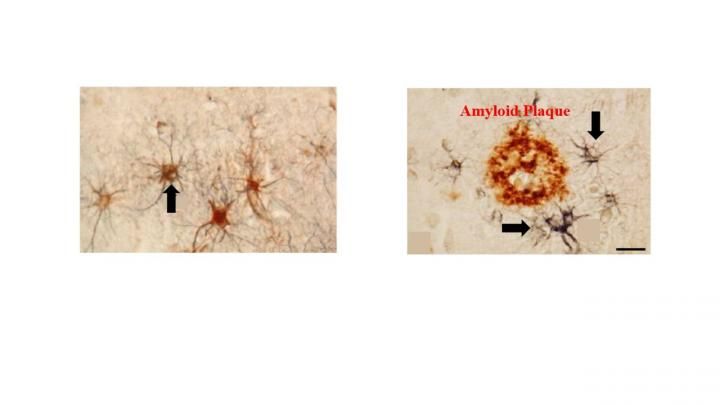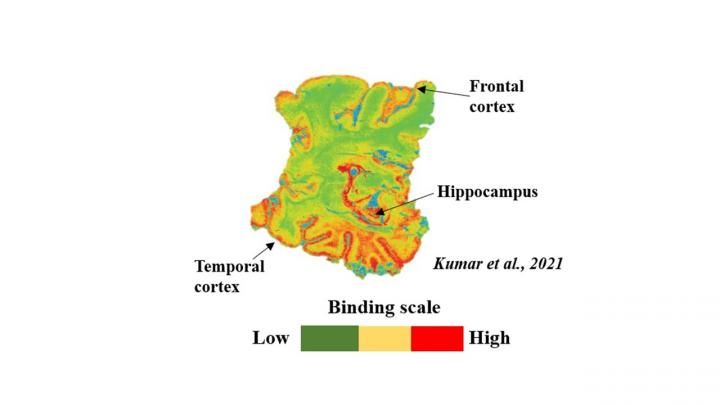New PET Tracer Offers Possible Early Alzheimer’s Detection
BU99008 traces reactive astrogliosis, a marker that provides early, rapid Alzheimer’s detection.
A new PET tracer – BU99008 – could play a key role in detecting the early stages of Alzheimer’s disease, according to newly published research.
Changes to brain function caused by Alzheimer’s can begin as early as 10-to-20 years before the cognitive decline is noticed clinically. Such early neurological alterations make the identification of early disease markers that much more critical.
In a new study published April 22 in Molecular Psychiatry, a multi-institutional team of investigators from Karolinska Institutet, Uppsala University, and Indiana University School of Medicine discussed how BU99008 can be used to trace reactive astrogliosis, a marker that can provide an early, rapid response to the progression of the disease.
Astrocytes in the brain of a deceased patient with Alzheimer's disease. (Right) The black arrows show astrocytes surrounding amyloid plaques in the brain of a deceased patient with Alzheimer's disease.
Credit: Amit Kumar

Astrocytes, the team said, are the most important homeostatic cells present in the central nervous system, and they perform a myriad of functions to maximize cerebral function and cellular energy supply.
“Our study shows that BU99008 can detect important reactive astrocytes with good selectivity and specificity, making it a potentially important clinical astrocytic PET tracer,’” said first author Amit Kumar, Ph.D., a researcher in the neurobiology, care sciences, and society department at Karolinska Institutet. “The results can improve our knowledge of the role played by reactive astrogliosis in Alzheimer’s disease.”
The binding of the PET-tracer BU99008 shows reactive astrogliosis in different parts of the brain of a deceased patient with Alzheimer's disease. The colours show the extent of the binding, where green is low, yellow is medium, and red is high binding.
Credit: Amit Kumar

For their study, the team examined brain tissue from six patients who died from Alzheimer’s, as well as seven other healthy individuals who died from other causes. Their results shed light on how the binding properties of BU99008 compare with other existing astrocytic Alzheimer’s disease brain biomarkers.
“As far as we can judge, this is the first time that BU99008 could visualize reactive astrogliosis in Alzheimer’s disease brain,” said principal investigator Agneta Nordberg, M.D., Ph.D., professor of clinical neuroscience at Karolinska Institutet. “The results can have broad clinical implications that cover other disorders of reactive astroglial dysfunction.”
For more coverage based on industry expert insights and research, subscribe to the Diagnostic Imaging e-Newsletter here.
Meta-Analysis Shows Merits of AI with CTA Detection of Coronary Artery Stenosis and Calcified Plaque
April 16th 2025Artificial intelligence demonstrated higher AUC, sensitivity, and specificity than radiologists for detecting coronary artery stenosis > 50 percent on computed tomography angiography (CTA), according to a new 17-study meta-analysis.
The Reading Room: Racial and Ethnic Minorities, Cancer Screenings, and COVID-19
November 3rd 2020In this podcast episode, Dr. Shalom Kalnicki, from Montefiore and Albert Einstein College of Medicine, discusses the disparities minority patients face with cancer screenings and what can be done to increase access during the pandemic.
Could Lymph Node Distribution Patterns on CT Improve Staging for Colon Cancer?
April 11th 2025For patients with microsatellite instability-high colon cancer, distribution-based clinical lymph node staging (dCN) with computed tomography (CT) offered nearly double the accuracy rate of clinical lymph node staging in a recent study.